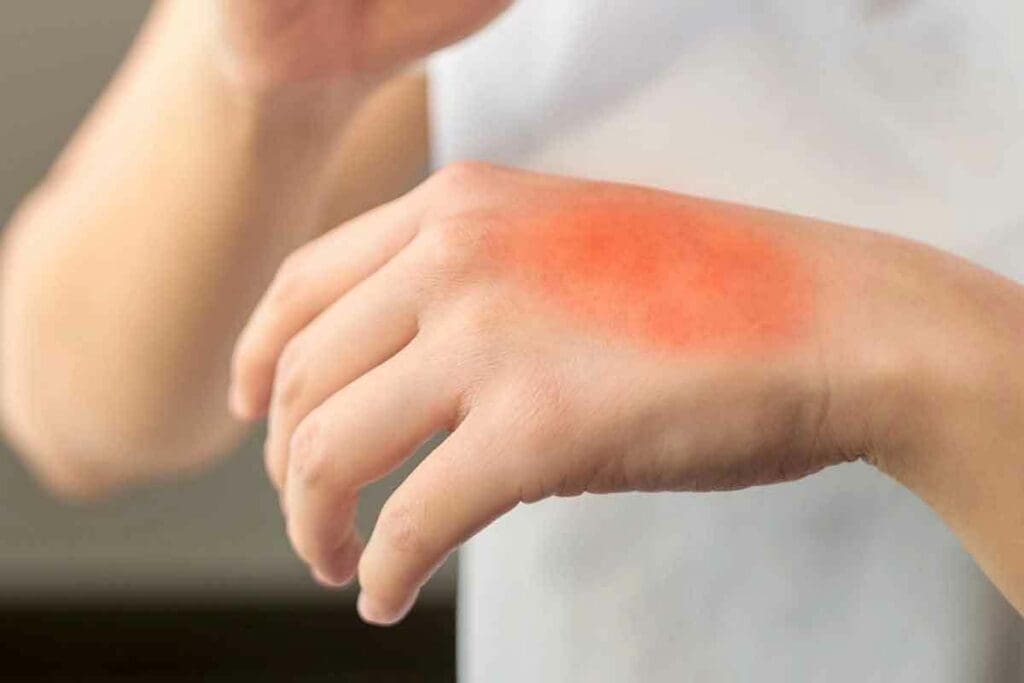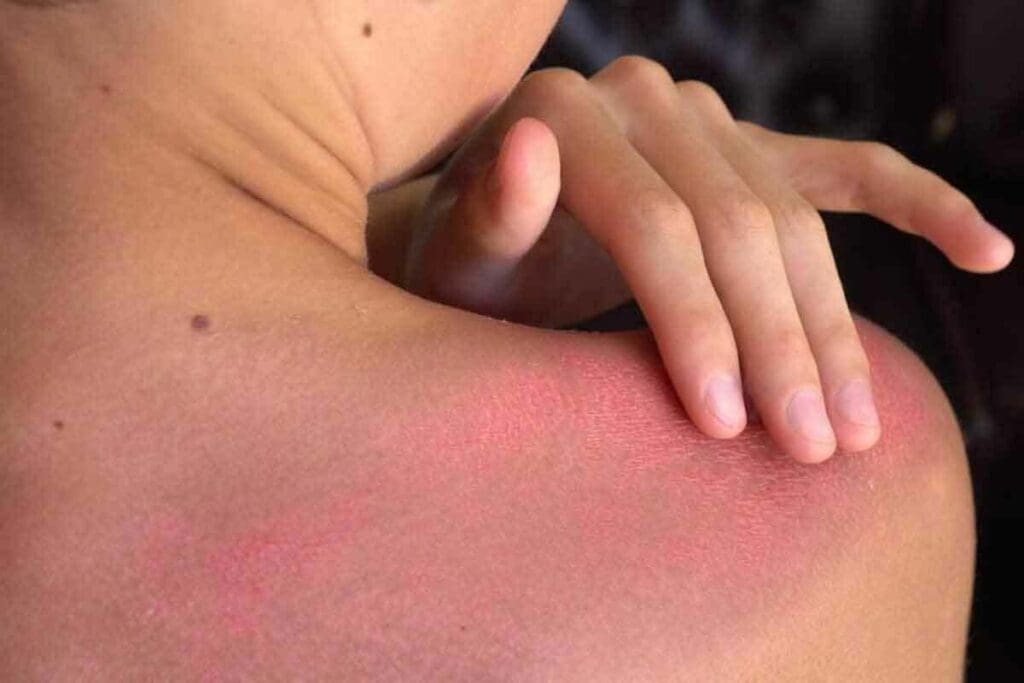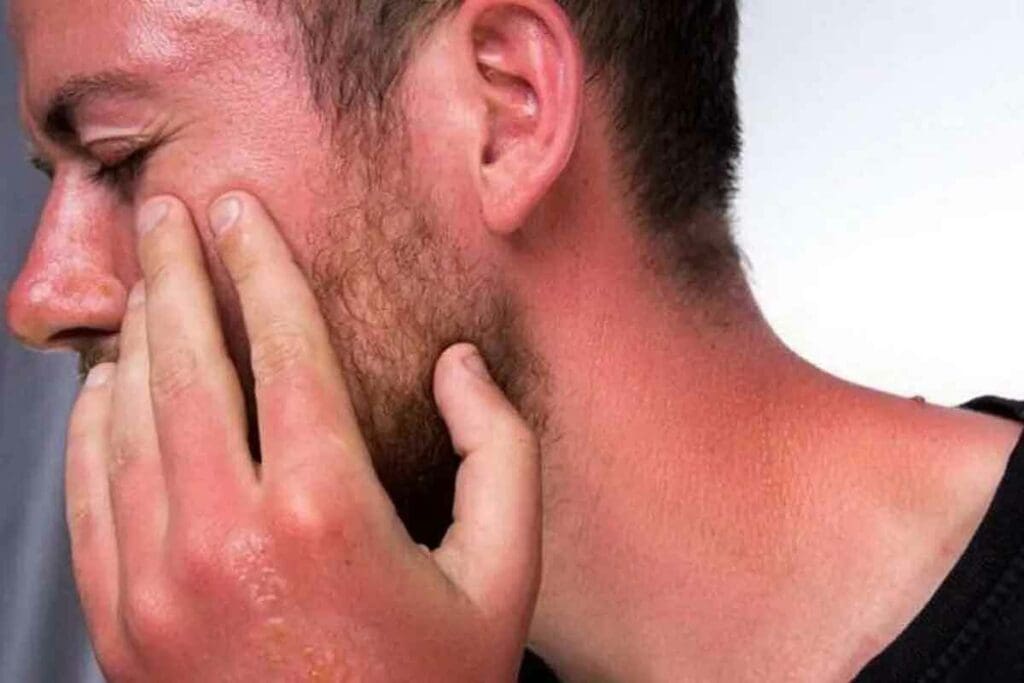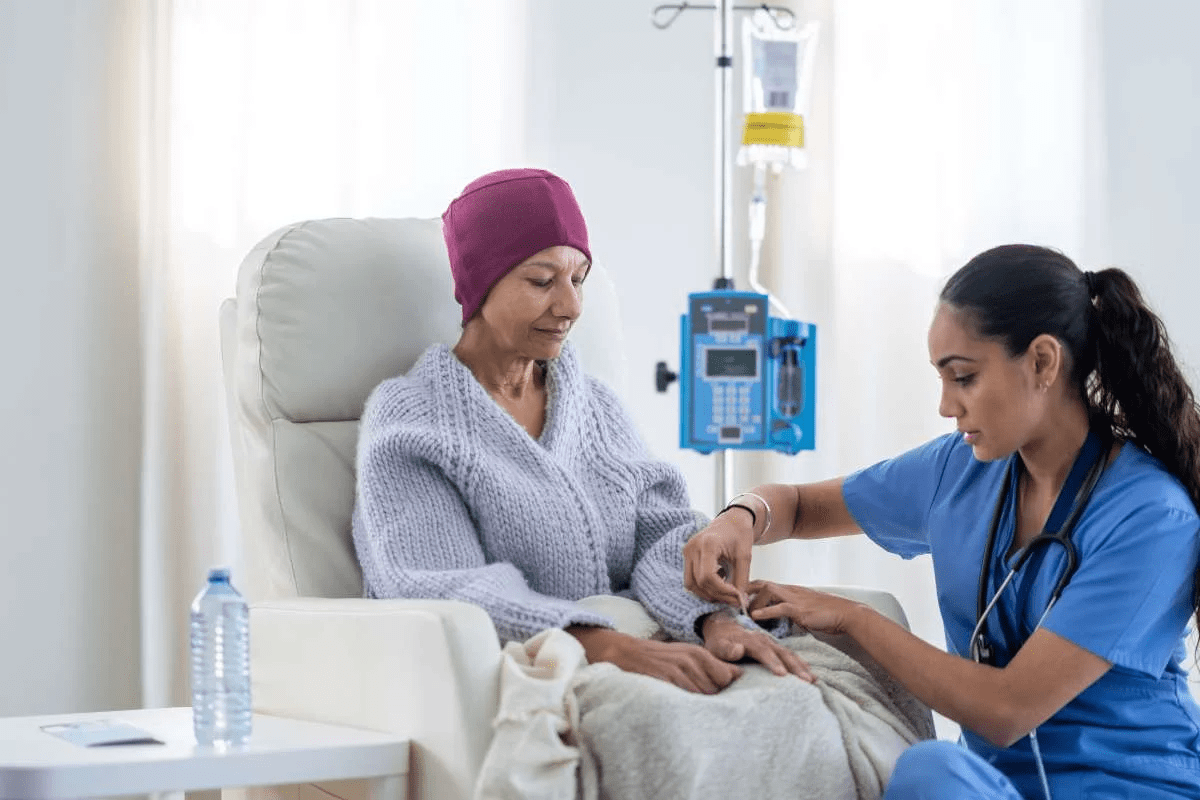Last Updated on November 27, 2025 by Bilal Hasdemir

Radiation dermatitis, also called radiation skin burns, is a common side effect of radiation therapy. It can cause redness, pain, blisters, and weeping lesions, which can significantly impact a patient’s quality of life.
At Liv Hospital, we understand how important it is to provide prompt and effective treatments for radiation burns. Our advanced, patient-centered care ensures that every patient receives the best support and medical attention at every stage of their skin injury.
Managing radiation blisters and other symptoms is essential for recovery. In this article, we share expert tips and outline the most effective treatments for radiation burns to help patients heal safely and comfortably.
Key Takeaways
- Understanding radiation dermatitis and its symptoms
- The importance of timely treatment for radiation skin burns
- Overview of effective treatments for radiation therapy burns
- Care tips for managing radiation blisters and other symptoms
- Supportive care options available for patients
Understanding Radiation Burns and Radiation Dermatitis

When people get radiation therapy, they might get skin reactions. These are called radiation burns or dermatitis. They can be mild or severe. How someone reacts can depend on where the treatment is, the type of radiation, and the dose.
What Are Radiation Burns?
Radiation burns happen when the skin is exposed to too much radiation. This damages the skin cells and can cause lasting changes. The Centers for Disease Control and Prevention says it’s important to know about radiation burns.
Radiation dermatitis is another name for radiation burns. It shows how the skin reacts to radiation.
How Radiation Therapy Affects the Skin
Radiation therapy harms the skin’s outer layer by damaging cells. This can cause symptoms like redness and dryness. In severe cases, it can lead to blisters and weeping lesions. The severity depends on the radiation dose, treatment area, and individual factors.
Common Symptoms: From Redness to Weeping Lesions
People can react differently to radiation burns. Symptoms can range from mild redness to severe blisters. Here are some common ones:
- Redness and erythema
- Dry desquamation
- Moist desquamation
- Blistering
- Weeping lesions
These symptoms can be uncomfortable and affect daily life. Knowing what to expect can help manage them better.
| Symptom | Description | Management Tips |
| Redness | Mild inflammation | Keep the area clean and moisturized |
| Dry Desquamation | Dry, flaky skin | Use gentle moisturizers |
| Moist Desquamation | Wet, weeping skin | Apply topical creams as prescribed |
“The management of radiation dermatitis requires a complete approach. This includes prevention and timely actions to lessen its impact on patients’ lives.”
— Expert in Radiation Oncology
Types and Severity of Radiation Skin Burns

It’s important to know how bad radiation skin burns can be. This is because radiation dermatitis, a common side effect of radiation therapy, can vary in severity.
Grading Systems for Radiation Dermatitis
Radiation dermatitis is graded from 1 to 4. Grade 1 is the mildest, and Grade 4 is the most severe. This helps doctors figure out how bad it is and choose the right treatment.
| Grade | Symptoms |
| 1 | Mild redness, slight dryness |
| 2 | Moderate redness, dry desquamation |
| 3 | Severe redness, moist desquamation |
| 4 | Ulceration, necrosis |
What Do Radiation Burns Look Like at Different Stages
Radiation burns can get worse, from mild redness to severe ulcers. At first, you might just see some redness and dry skin. But as it gets worse, the skin can become very damaged, leading to serious problems.
A study in a medical journal found that early treatment can greatly reduce the severity of radiation dermatitis.
Early treatment of radiation dermatitis is key to avoiding long-term damage and improving patient outcomes.
Identifying Radiation Blisters and Weeping Wounds
Severe radiation burns can cause blisters and weeping wounds. These need careful care to avoid infection and help them heal. These wounds are moist and raw, with skin that’s weeping.
Key characteristics of radiation blisters and weeping wounds include:
- Moist, raw skin
- Presence of exudate
- Increased risk of infection
Managing these severe reactions well involves using the right dressings and wound care. This helps them heal and reduces complications.
Prevention Strategies Before Starting Radiation Therapy
To lower the risk of radiation burns, it’s key to prepare the skin well and take protective steps during therapy. We’ll share ways to prevent burns before and during treatment. This makes the process smoother.
Skin Preparation Guidelines
Getting the skin ready for radiation therapy is very important. We suggest gentle skin care, like using soft soaps and avoiding harsh products. Keeping the skin clean and dry is also vital.
It’s best to wear loose, comfy clothes to lessen skin friction. Also, stay away from extreme temperatures and direct sunlight to avoid more irritation.
Protective Measures During Treatment
Using protective steps during therapy can greatly lower burn risks. Shielding devices can cover areas not being treated. Custom-made boluses help ensure the right dose goes to the right spot.
Dosimetry-Guided Therapy to Minimize Skin Damage
Dosimetry-guided therapy is a smart way to cut down skin exposure. This method lets us plan treatments just right, reducing burn risks and improving therapy results.
By following these prevention tips, patients can greatly lower their chance of severe skin damage. This makes treatment more comfortable and successful.
Effective Treatments for Radiation Burns: Medical Approaches
Managing radiation burns involves several medical methods. These methods help ease symptoms and aid in healing. Radiation burns are a common side effect of radiation therapy.
Evidence-Based Treatment Options
There are many treatments for radiation burns. Topical treatments like steroid creams are effective. They have anti-inflammatory properties.
How Steroid Creams Work for Radiation Burns
Steroid creams reduce inflammation and help skin heal. They work by calming the immune system. This lessens redness, swelling, and pain.
Multidisciplinary Care Pathways
For severe radiation burns, a team approach is best. This team includes oncologists, dermatologists, and wound care specialists. They work together to create a detailed treatment plan.
| Healthcare Professional | Role in Managing Radiation Burns |
| Oncologist | Oversees radiation therapy and manages overall cancer treatment |
| Dermatologist | Provides expertise on skin conditions and topical treatments |
| Wound Care Specialist | Focuses on wound healing and managing complex skin injuries |
When to Seek Medical Intervention
Seek medical help if symptoms get worse or show signs of infection. Early treatment can prevent complications and help with healing.
Key indicators for seeking medical help include: severe pain, significant blistering or weeping, and signs of infection.
Treatment #2: Hydrocolloid and Advanced Dressings
Advanced dressings, like hydrocolloid options, are changing how we treat radiation burns. They create a moist environment that helps wounds heal. These dressings are great for weeping wounds.
Benefits of Moisture-Retentive Dressings
Hydrocolloid dressings keep wounds moist, which aids in healing. Moisture-retentive dressings also lower the chance of infection. They protect the wound, which is key for radiation burns.
These dressings also reduce pain and discomfort. They prevent scabbing, which can be painful and cause more problems.
Application Techniques for Weeping Radiation Burns
When using hydrocolloid dressings on weeping radiation burns, follow these steps. First, clean the wound with saline to remove dirt and bacteria. Then, dry it before applying the dressing.
To apply, remove the backing and place it over the wound. Make sure it covers the edges well. Smooth out any air bubbles or wrinkles to avoid irritation.
Frequency of Dressing Changes for Optimal Healing
Changing dressings often is key to healing. For weeping radiation burns, change them when the dressing gets dirty or loses stickiness. This can be daily or every 3-4 days, depending on the wound.
Keep an eye on how the wound is healing and adjust dressing changes as needed. Regular assessment by healthcare professionals is vital. They can adjust the schedule for each patient to ensure the best healing.
Treatment #3: Antimicrobial and Antibiotic Treatments
Antimicrobial and antibiotic treatments are key in treating radiation burns. It’s vital to stop infections in damaged skin. Infections can cause serious problems.
Preventing Infection in Radiation-Damaged Skin
Stopping infections is a main goal in treating radiation burns. We use antimicrobial treatments to lower infection risk. Antimicrobial dressings are great because they stop microbes from growing.
Using dressings with silver or iodine is recommended. These ingredients fight off many microbes. Also, keeping hands clean when handling dressings is important to avoid germs.
Recommended Antibiotic Ointments
Antibiotic ointments help prevent infections in radiation burns. We suggest ointments with bacitracin or neomycin. These fight off many bacteria.
| Antibiotic Ointment | Active Ingredient | Benefits |
| Bacitracin ointment | Bacitracin | Effective against Gram-positive bacteria |
| Neomycin ointment | Neomycin | Effective against a broad spectrum of bacteria |
Managing Infected Radiation Burns
Infected radiation burns need quick medical care. We check the infection’s severity and plan treatment. This might include antibiotics or topical treatments.
Signs of infection include redness, swelling, pain, or pus. If you see these signs, get medical help fast. We also watch the wound and change treatment plans if needed.
Treatment #4: Growth Factor Therapies and Biological Dressings
Growth factor therapies and biological dressings are new ways to treat radiation burns. They are changing how we manage radiation dermatitis. These methods are showing great promise.
Plasma-Based Biomaterials for Severe Cases
Plasma-based biomaterials are helping treat severe radiation burns. They come from the patient’s own plasma, which has growth factors for healing. This makes a good environment for wounds to heal.
Creating these biomaterials starts with taking the patient’s blood. The plasma is then processed into a material for the wound. It speeds up healing and lowers the chance of infection.
Mesenchymal Stem Cell Therapies: Current Research
Mesenchymal stem cell (MSC) therapies are also being researched for radiation burns. MSCs can turn into different cell types, including skin cells. This makes them great for regenerative medicine.
Researchers are studying how MSCs can fix damaged skin and help radiation burns heal. MSCs can calm the immune system, reduce swelling, and help repair tissues. Early results are promising, showing new ways to treat severe radiation burns.
As we learn more about growth factor therapies and biological dressings, it’s clear they will change how we treat radiation burns. They use the body’s healing powers to give better care to patients with radiation dermatitis.
Treatment #5: Surgical Interventions for Severe Radiation Burns
Severe radiation burns often need surgery to heal. When skin damage from radiation therapy is significant, surgery is key.
When Surgery Becomes Necessary
Surgery is needed for severe burns that don’t respond to other treatments. We check the damage to decide if surgery is needed.
Choosing surgery depends on the burn’s depth, size, and the patient’s health.
Debridement and Skin Grafting Procedures
Surgery for severe burns includes debridement and skin grafting.
| Procedure | Description | Benefits |
| Debridement | Removal of dead tissue to promote healing | Reduces risk of infection, promotes granulation |
| Skin Grafting | Transplanting healthy skin to the affected area | Covers wounds, aids in healing, and reduces scarring |
Debridement removes dead tissue to help healing. Skin grafting covers the wound, aiding recovery and reducing scarring.
Recovery and Follow-up Care After Surgical Treatment
Post-surgery, we focus on care to ensure recovery. This includes watching for infection, managing pain, and developing a rehabilitation plan.
Follow-up care is vital to check the surgery’s success and handle any issues.
Treatment #6: Natural and Alternative Remedies
Some people try natural remedies to help with radiation burn symptoms. These treatments can help, along with standard medical care. They support the healing process.
Aloe Vera and Other Plant-Based Treatments
Aloe vera is a popular natural remedy for radiation burns. It has anti-inflammatory properties that can soothe the skin. Aloe vera gel helps with healing and keeps the skin hydrated.
Other plants like chamomile and tea tree oil might also help. But it’s important to use them with a doctor’s advice to avoid problems.
Calendula and Other Botanical Options
Calendula is known for its healing properties and is used for radiation burns. Calendula cream or ointment can help the skin heal faster and reduce swelling.
Lavender oil might also help with pain and itching from radiation dermatitis. It’s essential to consult with a healthcare provider before trying new remedies, even if you’re getting radiation therapy.
Evidence for Complementary Approaches to Radiation Burn Care
There’s some evidence that natural remedies can help with radiation burns. But more research is needed to confirm this. A study on PubMed Central looks into the benefits of these therapies for radiation dermatitis.
Research shows:
- Aloe vera may lessen the severity of radiation dermatitis.
- Calendula cream can improve wound healing and reduce swelling.
- Botanicals like chamomile and lavender might help with symptoms.
As research grows, it’s clear that combining traditional and natural treatments can offer the best care for radiation burns.
Treatment #7: Pain Management and Supportive Care
Managing pain is key for patients with radiation injuries. It’s vital for improving their quality of life.
Topical Pain Relief Options
Topical pain relief is important for radiation burns. It includes:
- Topical anesthetics like lidocaine
- Cooling gels or sprays
- Moisturizing creams to prevent dryness and cracking
A study in the Journal of Pain Research found that lidocaine helps with radiation dermatitis pain.
“Topical lidocaine is effective in reducing the pain associated with radiation dermatitis, improving the patient’s quality of life.”
Systemic Pain Management Approaches
For some, systemic pain management is needed. This includes:
- Oral analgesics such as acetaminophen or NSAIDs
- Opioid medications for severe pain
- Adjuvant therapies like gabapentin for neuropathic pain
| Pain Management Approach | Indications | Benefits |
| Topical Anesthetics | Localized pain, radiation dermatitis | Effective for surface-level pain, with minimal side effects |
| Oral Analgesics | Moderate pain, inflammation | Easy to administer, effective for various pain types |
| Opioid Medications | Severe pain | Highly effective for intense pain, rapid relief |
The Role of Burn Units in Severe Radiation Injury Care
Specialized burn units are essential for severe radiation injuries. They have teams skilled in complex burn care, including radiation cases.
We stress the need for a full care plan. This includes pain management, wound care, and supportive therapies for the best patient results.
Conclusion: Long-Term Management and Recovery
Effective radiation burn care is key for those getting radiation therapy. We’ve talked about treatments like emollients, film-forming silicone gel, and topical steroids. These can help manage radiation dermatitis.
Managing radiation burns long-term is essential for recovery. Patients should keep using emollients daily for 6 months to a year after treatment. For more severe cases, protective dressings are recommended. Silver dressings might be needed for infections.
Knowing the risks of radiation dermatitis helps doctors plan better. Factors like the type of radiation and how it’s given matter. A good care plan can help patients recover well and avoid long-term problems.
We stress the need for ongoing care for radiation burn patients. They need the right treatments to heal well and manage their condition long-term.
FAQ
What are radiation burns, and how do they occur?
Radiation burns, also known as radiation dermatitis, happen when skin is exposed to too much radiation during treatment. This can damage the skin, causing redness, itching, and blisters.
How can I prevent radiation burns during radiation therapy?
To avoid radiation burns, follow skin prep guidelines and use protective gear during treatment. Also, consider treatments that focus on minimizing skin damage.
What are the common symptoms of radiation burns?
Symptoms include redness, itching, dryness, and blisters. Severe cases can lead to open sores and weeping lesions.
How are radiation burns treated?
Treatment varies based on the burn’s severity. It may include evidence-based treatments, multidisciplinary care, and the use of special dressings. Antimicrobial and antibiotic treatments, growth factors, and biological dressings are also used.
What is the role of hydrocolloid dressings in treating radiation burns?
Hydrocolloid dressings create a moist environment that aids healing. They’re great for weeping burns and help prevent infection.
How can I manage pain associated with radiation burns?
Managing pain involves using topical and systemic treatments. Supportive care and specialized units can also help with severe injuries.
Are there any natural or alternative remedies for radiation burns?
Natural remedies like aloe vera and calendula may help. But always talk to a doctor before trying them.
When is surgery necessary for radiation burns?
Surgery is needed for severe burns that don’t respond to other treatments. It may include removing dead tissue and grafting new skin.
How can I prevent infection in radiation burns?
Preventing infection involves using treatments that fight bacteria and keeping the area clean. Watch for signs of infection, too.
What are the emerging treatments for radiation burns?
New treatments include growth factors, biological dressings, and stem cell therapies. These offer hope for severe burns.
References:
- American College of Radiology. (2024). ACR Appropriateness Criteria®. https://www.acr.org/Clinical-Resources/Clinical-Tools-and-Reference/Appropriateness-Criteria






